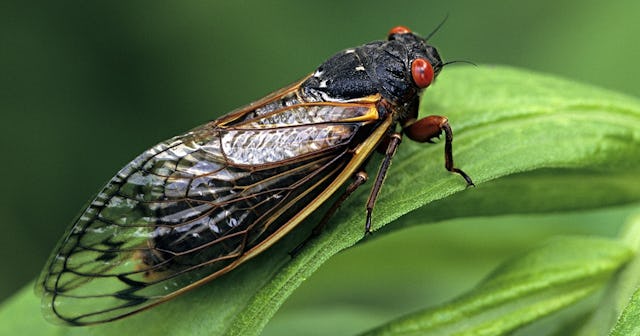Millions Of Cicadas Expected To Emerge From The Ground This Summer

Of course 2020 — the year of a global pandemic and murder hornets — just so happens to be the year that millions of flying insects called cicadas will crawl out of the ground for their mating cycle, whilst chirping ever so loudly — and incessantly.
Every 13 or 17 years (depending on the species), as many as 1.5 million cicadas per acre emerge to mate. This year, it’ll take place in southwestern Virginia, parts of North Carolina, and West Virginia. It’s incredibly obvious when they’re out and about, too, because, as part of the ritual, the male cicadas let out a noisy mating call.
According to Virginia Tech and Virginia State University, the number of cicadas traditionally start in May, peak in early June, with most gone by July. And don’t worry should you run into them; cicadas are not poisonous, and they don’t have a stinger.
“After 13 or 17 years below ground, mature nymphs construct a mud turret called a cicada hut and emerge from the soil and climb onto nearby vegetation or any vertical surface. They then molt to the winged adult stage,” according to VT and VSU. “Their shed outer skins or ‘exoskeletons’ are frequently found attached to tree trunks and twigs. The emergence is often tightly synchronized, with most adults appearing within a few nights.”
They go on to explain that male cicadas sing by vibrating membranes on the sides of the “first abdominal segment.” Females, on the other hand, are silent.
“Communities and farms with large numbers of cicadas emerging at once may have a substantial noise issue,” Eric Day, Virginia Cooperative Extension entomologist in Virginia Tech’s Department of Entomology in the College of Agriculture and Life Sciences, tells Virginia Tech Daily. “Hopefully, any annoyance at the disturbance is tempered by just how infrequent — and amazing — this event is.”
This year, the aforementioned affected area can expect the brood IX cicada, which last made its appearance in 2003. And as for why cicadas emerge in such cycles, it’s theorized that cicadas have evolved to “avoid synching up with predator cycles by having a 13- or 17-year prime number emergence interval,” Virginia Tech Daily reports.
“This insect is really fascinating, and if you don’t have fruit trees or grapevines to protect, you can enjoy this phenomenon while it lasts,” said Doug Pfeiffer, a professor and extension specialist in the Department of Entomology.